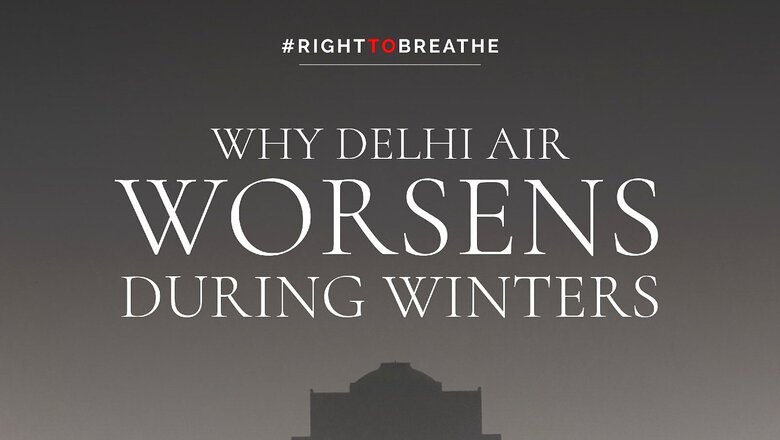
views
Air pollution in Delhi is prevalent throughout the year. However, air pollution increases during the post-monsoon months due to a combination of atmospheric conditions and human factors. As soon as winter descends on Delhi, the city can expect air that is more than twice as polluted as during the spring and summer.
Winter inversion, the valley effect in addition to industrial emissions, and vehicular emissions are some of the reasons for the increasing amount of air pollution in winter. Dust storms, crop fires, burning of solid fuels for heating, as well as firecracker-related pollution during Diwali also increase winter pollution.
Let us study in detail the reasons behind this soaring pollution with ClassesWithNews18:
Stubble burning
As winter nears, the Air Quality Index (AQI) raises concerns. People in Delhi-NCR choke in a blanket of smog as air pollution due to stubble-burning cripples the region every winter. It’s that time of the year when the issue of paddy stubble burning comes to haunt the city.
In 2021, the average contribution of stubble burning to Delhi’s PM2.5 level in November was 14.6 per cent, according to data from the government-run monitoring agency SAFAR (System of Air Quality and Weather Forecasting and Research). The annual contribution is usually far lesser since the burning of stubble is only a seasonal activity and not all year round.
The effect of stubble burning on pollution in Delhi and NCR has been a political hot potato with the Delhi Government blaming neighbouring states for the hazardous dip in air quality during winter. The highest contribution of stubble burning to PM2.5 in Delhi for a day was 58% in 2018, 43% in 2019, and 46% in 2020.
What are the sources of air pollution in Delhi?
Pollutants over Delhi mainly consist of:
PM- Particulate matter ( PM 2.5 and PM 10)
O3 – Ozone
SO2 – Sulphur Dioxide
NO2 – Nitrogen Dioxide
CO – Carbon monoxide
And on the other side, we have the greenhouse gases (GHGs) like carbon dioxide (CO2), which also has an impact on health, but more decisively linked to climate change.
Contributors of air pollution:
25%- Vehicles
26%- Biomass burning
8%- Solid waste burning
5%- Ash
4%- Dust
2%- Construction
Most of the PM2.5 pollution comes is combustion based. For example, more than 95% of emissions from diesel, petrol, and natural gas combustion, open waste burning pollution, biomass burning pollution, and coal combustion at cookstoves and boilers, falls under PM2.5.
Most of the PM10 pollution comes from mechanical processes – like dust, on the roads due to the constant vehicular movement, at the construction sites, and the seasonal dust storms. Close to 80% of the dust (that we commonly find on the roads) falls into the size fraction between PM2.5 and PM10. This is the main reason for finding more dust in a PM10 sample compared to a PM2.5 sample.
The winter pollution crisis:
Delhi’s air pollution problem aggravates during winters due to seasonal and atmospheric factors:
Seasonal factors
The level of PM2.5 is exceptionally high in winter and the reason is a lot of polluting activities increase during winter. Burning of biomass to warm up their homes and firecracker-related pollution because of festival like Diwali are some major factors.
The increasing number of brick kilns, which operate mainly in winter is one more reason for the high level of PM2.5 in winter. In fact, 15% of PM 2.5 that affects Delhi is because of brick kilns.
Atmospheric factors – As the winter season sets in, dust particles and pollutants in the air become unable to move. Due to stagnant winds, these pollutants get locked in the air and affect weather conditions, resulting in smog.
What is winter inversion?
During the summer season, the lowest layer of the atmosphere is warmer and lighter as compared to winter, which makes it easy for air to rise upwards. As a result, the pollutants are carried away from the ground. However, during the winter season, the air near the atmosphere of the earth is dense and cooler. The warm air traps the cool air and forms a kind of atmospheric lid, which is known as inversion.

The vertical mixing of air happens within this layer, as a result of which the pollutants disperse back into the atmosphere. The effects of inversion are strong at night for which the air quality deteriorates at night. This is the reason why experts advise people to avoid going for morning walks or exercising in the morning as the pollution levels are high.
Other reasons for the rise in pollution
A major contributor to air pollution and smog in Delhi is the traffic menace. Air pollution and smog are becoming more hazardous as a result of vehicular emissions. According to the Central Pollution Control Board (CPCB) and National Environmental Engineering Research Institute (NEERI), vehicular emissions contribute significantly to Delhi’s air pollution problems.
Over-pollution is another reason of air pollution in the capital. A growing population only contributes to the various forms of pollution, whether it is air pollution or noise pollution.
Investing less in public infrastructure is another reason for air pollution. Due to low investments in public transport and infrastructure, Indian roads are congested, causing air pollution.
There is also an increase in pollution from industrial sources and garbage dumps, which leads to the building up of smog in the air.
What about other regions?
In cities closer to the coast, like Mumbai and Chennai, the sea breeze and moisture help disperse pollution. The Indo-Gangetic plain is landlocked by the Himalayas and other mountain ranges. Polluted air in this region is unable to escape due to low wind speeds. This results in smog over most of north India.
The worst smog in history
London smog of 1952- The increase in pollution in winter is a global phenomenon. It first made headlines during the Great Smog of London, a lethal smog that covered the city of London for five days (December 5–9) in 1952. On December 5, an anticyclone settled over London. Consequently, the emissions of factories and domestic fires remained trapped near ground level due to inversion. 12,000 Londoners lost their life due to this smog. Its aftermath forced Britain to enforce stricter air quality norms.
To learn about other topics taught in school, explained by News18, here is a list of other Classes With News18: Queries Related to Chapters on Elections | Sex Versus Gender | Cryptocurrencies | Economy & Banks | How to Become President of India | Post Independence Struggle | How India Adopted Its Flag | Formation of States & United India | Tipu Sultan | Indian Teachers Day Different from Rest of the World | Journey of Kohinoor | Nobel Prize | Gandhi and Hate Crimes |
Read all the Latest Education News here



















Comments
0 comment